|
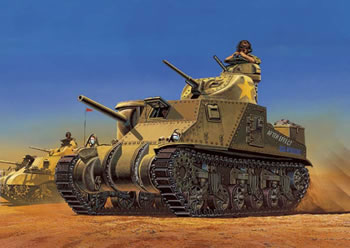 Academy
Hobby Model Company Academy
Hobby Model Company
13206
Academy
has come to the rescue of Allied modelers everywhere who clamored for an M3 Lee.
They have come forward with a new kit which represents the bolted hull. Others
are sure to follow as can be told from the sprue break down. The
kit comes in a standard sized Academy box with a nice painting of the Lee in one
of the schemes offered. Some have pointed out that the painting has six open spokes
on the roadwheels but the kit has the correct pattern. All the items within the
box were packaged with the exception of the lower hull tub. This was loose but
did not suffer any scratches. Only one item, part 20 from Sprue E, had broken
loose but it was in the bag. The
Kit The
parts are molded in the same green as Academy’s Allied kits and the styrene
is not brittle so cutting, sanding, and gluing are easily accomplished. Details
on the parts are sharp and the bolted surfaces have been rendered separately so
as to not lose fidelity. 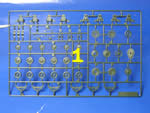 Photo
1 shows that Sprue A is the same running gear found in most of Academy’s
Sherman-based kits. This made its debut with the M-12 and the exhausts, part 8,
are still there. However, this is a very nice sprue and guarantees that the open
spoked wheels have the correct number as opposed to those depicted in the box
art. Your spares box will receive 34 parts from the duplicate sprues that are
provided to ensure enough parts. Photo
1 shows that Sprue A is the same running gear found in most of Academy’s
Sherman-based kits. This made its debut with the M-12 and the exhausts, part 8,
are still there. However, this is a very nice sprue and guarantees that the open
spoked wheels have the correct number as opposed to those depicted in the box
art. Your spares box will receive 34 parts from the duplicate sprues that are
provided to ensure enough parts.
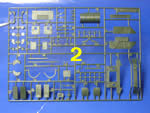 Sprue
B is shown in photo 2. Here, many of the external plates can be found. I was surprised
to see pinmarks on the outside face of B1 which represents the upper rear hull
plate. While they are shallow and can be easily removed, the rear of the part
would be hidden and a better place to have put the push pins. I hope that Academy
will reverse the part in future releases so that the pinmarks will not be visible.
Also, the starter hole will need to be drilled out. The three-part differential
cover is found here. A cast texture will need to be added and there are some casting
identification marks visible. These include A1658 on the sponson gun side and
E1230 ©1 on the left differential cover plate. Sprue
B is shown in photo 2. Here, many of the external plates can be found. I was surprised
to see pinmarks on the outside face of B1 which represents the upper rear hull
plate. While they are shallow and can be easily removed, the rear of the part
would be hidden and a better place to have put the push pins. I hope that Academy
will reverse the part in future releases so that the pinmarks will not be visible.
Also, the starter hole will need to be drilled out. The three-part differential
cover is found here. A cast texture will need to be added and there are some casting
identification marks visible. These include A1658 on the sponson gun side and
E1230 ©1 on the left differential cover plate.
The
hull hatches, which are separate, are found on this sprue. They are well detailed
on both sides and include the latch detail with the hasp molded in place. So,
the detail-oriented modeler may wish to remove the hasp and carefully drill out
the slot for it. Then a replacement hasp made from fuse wire can be added to the
hull plates. Of course, one can also wait for the inevitable photo-etched detail
sets that will follow this release. 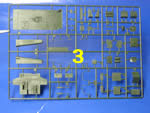 Photo
3 shows the sprue with the interior details. Since most of the hull interior details
are on Sprue C, it is possible that a future release without an interior may come.
The underside of Part C1, the hull floor, has a raised oval section that fits
the oval cutout of the lower hull tub but I do not see any reference photos showing
this feature so the modeler will have to putty and sand as the fit is not tight.
The oval opening in the bottom of the lower hull tub (see photo 8) may be to accomodate
a future radio-control version like Academy's Tiger 1 kit. The treadplate
pattern on some of the floor plate items is unusual and I plan to replace it with
some LionRoar PE. Photo
3 shows the sprue with the interior details. Since most of the hull interior details
are on Sprue C, it is possible that a future release without an interior may come.
The underside of Part C1, the hull floor, has a raised oval section that fits
the oval cutout of the lower hull tub but I do not see any reference photos showing
this feature so the modeler will have to putty and sand as the fit is not tight.
The oval opening in the bottom of the lower hull tub (see photo 8) may be to accomodate
a future radio-control version like Academy's Tiger 1 kit. The treadplate
pattern on some of the floor plate items is unusual and I plan to replace it with
some LionRoar PE.
Ammunition
boxes are included and the 75mm box shows 20 cartridge bases in the box. The cover
is a separate part so the cartridge bases are visible. Part C13 is the instrument
panel and the dials are engraved. I will scrounge up some decals from Reheat to
make them stand out. 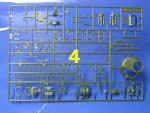 Sprue
D (photo 4) shows slide molding in effect for the cast contours below the commander’s
hatch on the turret, and sliding pins have opened up the 37mm gun and both 75mm
main guns (photo 5). The two 75mm guns represent the shorter M2 and the longer
M3. None of the guns have any rifling but I do have a set from On The Mark Models
which will provide them. The guns have a slight seam to be polished out with a
Flexi-File and it will be easy as the mold halves are perfectly aligned. Sprue
D (photo 4) shows slide molding in effect for the cast contours below the commander’s
hatch on the turret, and sliding pins have opened up the 37mm gun and both 75mm
main guns (photo 5). The two 75mm guns represent the shorter M2 and the longer
M3. None of the guns have any rifling but I do have a set from On The Mark Models
which will provide them. The guns have a slight seam to be polished out with a
Flexi-File and it will be easy as the mold halves are perfectly aligned.
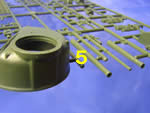 Cast
texture will need to be added to many of the parts and the 37mm gun mantlet has
casting marks ©D47321. The pistol/shell ejection port, part D52, is a separate
part and must be blended in to the main turret, D48. No provision is given to
model this port open. However, the modeler can position the side view covers of
the machine gun turret open, though Academy does not open the ports on the turret
itself. No interior detail is given to these ports. The 48 37mm shells are individually
molded. The tank tools are also on this sprue and the axe head seems a bit small.
Formations Models to the rescue. Cast
texture will need to be added to many of the parts and the 37mm gun mantlet has
casting marks ©D47321. The pistol/shell ejection port, part D52, is a separate
part and must be blended in to the main turret, D48. No provision is given to
model this port open. However, the modeler can position the side view covers of
the machine gun turret open, though Academy does not open the ports on the turret
itself. No interior detail is given to these ports. The 48 37mm shells are individually
molded. The tank tools are also on this sprue and the axe head seems a bit small.
Formations Models to the rescue.
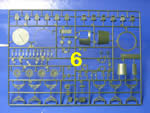 The
original vertical volute suspension with the return roller on top is provided
with Sprue E. The roadwheels, return rollers, idlers, and springs are to be taken
from Sprues A. Also note that the ‘lace’ sprockets without the fancy
machining are included. This shows an eye for detail as all the wartime photos
seem to show this type with open spoked idlers. The roadwheels can be either open
spoked welded, or spoked stamped types. Please check your references as to the
vehicle you’re modeling. [Editor's Note: It's been determined that the
bogie housing parts are about 2mm too tall, and can be corrected either through
some styrene surgery, or using replacement parts from Formations or Legend Productions.] The
original vertical volute suspension with the return roller on top is provided
with Sprue E. The roadwheels, return rollers, idlers, and springs are to be taken
from Sprues A. Also note that the ‘lace’ sprockets without the fancy
machining are included. This shows an eye for detail as all the wartime photos
seem to show this type with open spoked idlers. The roadwheels can be either open
spoked welded, or spoked stamped types. Please check your references as to the
vehicle you’re modeling. [Editor's Note: It's been determined that the
bogie housing parts are about 2mm too tall, and can be corrected either through
some styrene surgery, or using replacement parts from Formations or Legend Productions.]
The
turret basket is also found on this sprue along with more interior parts such
as the Homelite heater. Part E2, the turret basket floor, has two ejector pin
marks which are easy to remove as they are proud. The bottom of this part also
has numbers corresponding to the turret basket sides since it is made of four
pieces to allow for interior to be molded in place. 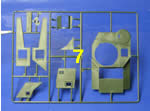 Sprue
F (photo 7) contains the bolted hull of this particular early variant. The plates
are all separate and exhibit good detail. Comparing to photos, some of the bolts
are actually screws so slots will need to be cut into some. The two glacis plate
machine gun ports are there. The top of the sponson rotor has a casting mark which
reads D37978. The engine deck and the bullet splash plates are separate parts
as is the egress hatch on the hull top. The rear wall of the fighting compartment,
part B32, will need some filler work which may destroy some of the round head
bolt detail. This is where I wish Academy had included extra bolts on a sprue
frame. Sprue
F (photo 7) contains the bolted hull of this particular early variant. The plates
are all separate and exhibit good detail. Comparing to photos, some of the bolts
are actually screws so slots will need to be cut into some. The two glacis plate
machine gun ports are there. The top of the sponson rotor has a casting mark which
reads D37978. The engine deck and the bullet splash plates are separate parts
as is the egress hatch on the hull top. The rear wall of the fighting compartment,
part B32, will need some filler work which may destroy some of the round head
bolt detail. This is where I wish Academy had included extra bolts on a sprue
frame.

 As
already mentioned, the lower hull tub (photos 8 and 9) has an oval cutout. While
the hull floor plate, part C1, has a square escape hatch engraved in it, the corresponding
hatch is not present on the lower hull. The rest of the detail on this part is
quite good and includes the transmission armor mounting bolts. Te be specific,
the lower row of bolts should actually be spaced differently to allow for the
three parts of the transmission cover armor. Being on the bottom of the hull,
this is not really an issue. As
already mentioned, the lower hull tub (photos 8 and 9) has an oval cutout. While
the hull floor plate, part C1, has a square escape hatch engraved in it, the corresponding
hatch is not present on the lower hull. The rest of the detail on this part is
quite good and includes the transmission armor mounting bolts. Te be specific,
the lower row of bolts should actually be spaced differently to allow for the
three parts of the transmission cover armor. Being on the bottom of the hull,
this is not really an issue.
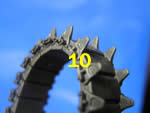 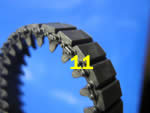 The
tracks are the rubber pad type and the details are sharp but there is a seam on
each which will be difficult to remove. Aftermarket options include sets from
ModelKasten, Friulmodel, RHPS, and Resicast for burnt Sherman tracks. Personally,
I will use RHPS due to cost. Should I ever consider burnt tracks, the best option
are ModelKasten tracks as they have the skeleton detail and I can model only a
portion of the tracks as burnt. The
tracks are the rubber pad type and the details are sharp but there is a seam on
each which will be difficult to remove. Aftermarket options include sets from
ModelKasten, Friulmodel, RHPS, and Resicast for burnt Sherman tracks. Personally,
I will use RHPS due to cost. Should I ever consider burnt tracks, the best option
are ModelKasten tracks as they have the skeleton detail and I can model only a
portion of the tracks as burnt.
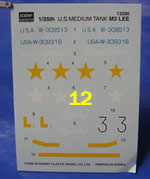 The
decals provide markings for two vehicles in North Africa. One is After Effect
during its tour in Bizerte, Tunisia, May of 1943, while the second is Kentucky
at Souk-el Khemis, Tunisia, during 1942. Both vehicles have blue registration
numbers and the latter one includes yellow stars and stripes. The former has a
black, outlined white, number three to display on the turret sides. The decals
are thin and glossy. My experiences with Academy decals are that they react well
to MicroScale’s system but the gloss coat means that a flat coat is necessary.
My Lee will be a Russian Lend-Lease vehicle so I will use dry transfers from Mig
Productions and Archer Fine Transfers. The
decals provide markings for two vehicles in North Africa. One is After Effect
during its tour in Bizerte, Tunisia, May of 1943, while the second is Kentucky
at Souk-el Khemis, Tunisia, during 1942. Both vehicles have blue registration
numbers and the latter one includes yellow stars and stripes. The former has a
black, outlined white, number three to display on the turret sides. The decals
are thin and glossy. My experiences with Academy decals are that they react well
to MicroScale’s system but the gloss coat means that a flat coat is necessary.
My Lee will be a Russian Lend-Lease vehicle so I will use dry transfers from Mig
Productions and Archer Fine Transfers.
The
instructions are in a booklet form with 12 pages and a correction addendum insert.
A one paragraph text covers an all too brief history along with accolades for
the manufacturer. Academy is confident! The assembly sequence is good and the
illustrations are clear. Photos of the completed model are included where necessary.
A painting and markings guide along with a parts map complete the instructions. Accuracy This
is a difficult thing to gauge. The Militaria book in the references used has plans
that match the ordnance drawings. The hull side plates and lower tub seem a bit
smaller than the plan view. While the book claims the plans to be to 1/35th scale,
no dimensions are given for the items shown in the plan. Since
there are several examples of the M3 Lee and Grant around, I will include some
measurements taken from the kit parts and list them. If anyone can provide corresponding
measurements from an actual vehicle (and the vehicle’s location), I will
update this review. Lower
hull tub measures 1.772 inches (45.04mm) wide, bogie spacing is 1.614 inches (41mm),
and the space from the last bogie to the idler shaft centerline is 1.2 inch (30.48mm).
As mentioned, some of the bolts are actually screws so slots will need to be cut.
The interior does match photos in books but one must remember that these are museum
examples. It is more complete than Verlinden Productions interior set designed
for the Tamiya kit so there is no use picking up this set in the hopes of improving
the kit. Acknowledgements I
would like to thank the following for offering assistance to allow me to better
gauge the accuracy of the kit: Kurt Laughlin, Roy Chow, and Tim Streeter. Finally,
thanks to MRC for providing an early review sample. References - Sherman,
A History of the American Medium Tank, by R. P. Hunnicutt.
- Allied-Axis,
Issue 10.
- M3
Grant and M4 Sherman, Militaria in Detail 3, by Wojciech J. Gawrych, published
by Wydawnictwo Militaria.
- Tanki
Lend-Liza 1941-1945 (Russian language), by M. Kolomietz & I. Moschansky,
published by Exprint.
- Lend
Lease Vol. II (Polish language) by M. Kolomietz & I. Moschansky, published
by Wydawnictwo Militaria.
- Captured
American & British Tanks under the German Flag, by Werner Regenberg, published
by Schiffer Military History.
-Saul
Garcia
For a comparison with the Tamiya M3Lee kit, read Tim's construction
article.
| 












 Academy
Hobby Model Company
Academy
Hobby Model Company










